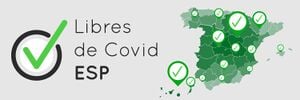This page brings together measures to reduce the number of respiratory contacts, with details for several specific areas, a guiding concept for redesign systems based on needs, and with ideas (see below) for apps to help achieve the goal.
It is assumed that in addition, in each environment, measures are applied to reduce transmission when people are sharing the same space, especially if this space is enclosed.
There's work modeling the effect of doing this. Bring it here?
At work[edit | edit source]
Several strategies, alone or combined, could be used to reduce the number of respiratory contacts at work.
- Prioritise: a fraction of the tasks could be postponed.
- Daily and hourly shifts. For illustration, let's imagine an office with 12 workers. Half of them could work during the early hours of the day, and half of them later, reducing the density by 50%. Additionally, half of them could work in the office on Mondays, Wednesdays, and Fridays and half in the other days of the week, further reducing the number of people sharing the space.
- Teleworking is an option in some jobs. This may benefit from up-to-date telecommunication technologies, but could be done using phones, designing part of the work to be done at home, etc. Teleworking might be augmented by having connection between similar jobs: doctors do that routinely when they consult with someone who has more experience while they are taking care of say rural populations.
- Another strategy would be to have "distributed offices": a small number of workers might gather in a private place, meet outdoors, etc.
- In some jobs, the contacts that can be reduced are not between workers but rather with customers. The general strategy would be "asynchronous transfer", as in leaving the bike you need repaired against a wall, instead of in the hands of the person doing the work.
More ideas in resiliencemaps.org/files/fluscim/FluSCIM-69p-English.pdf - they can be brought to these pages.
It would be good to 1) refine these suggestions and 2) turn them into cartoons for better understanding and implementation.
In public transportation[edit | edit source]
- Part is reduced by shifts and teleworking.
- Sharing vehicles (with masks and open windows) to decongest public transportation.
In education[edit | edit source]
- Small: micro-tribes. At home in small, stable groups. For example, 3 single-parent families, each with a 2-year-old child; they could coordinate, live in the larger dwelling, 1 adult cares for 3 children, etc.
- Medium: ruralization of urban schools, consisting of enabling peripheral premises as classrooms, with ventilation, toilet, internet connection or at least one computer, and accessibility for the safety of teachers and students. Saves the overcrowding of urban centers: corridors and stairs, toilets, playground and gymnasium, school canteen, etc.
- Large: assimilable to work, so shifts and telecommuting. Also ruralization of universities etc.
- In all: reduction of ratios, a combination of distance and face-to-face. Example: jumplogic.
On purchases[edit | edit source]
- In most cases, in non-pandemic times, we buy at the shop. Only a few customers are served by moving say their groceries to their homes; let's say it's 1%. Objective in a severe pandemic: go from that 1% to higher or much higher percentages, quickly. For example, 2% of the population: those who are isolated and quarantined. 5% of the population: essential workers. 20% of the population: the vulnerable. 100% of the population: very severe pandemic in which it is in everyone's interest to reduce infections as much as possible, or any situation in which it is in the interest of all to reduce the number of cases relatively quickly. How to plan that? A team, with representation from several food chains and transporters, could be a new organization to create ad-hoc SCIM-style systems Resilience Maps. The first such team could develop templates and make them open for others to use. Is there work already done? Please get in touch.
- Home delivery, store pick-up, pick-up at an intermediate point.
- On-line ordering or simplified shopping (basic food box).
- Neighborhood help: apps or signs at the entrance of the building.
- Vehicles: delivery vehicles; private vehicles; school buses that are not being used due to lack of regular schooling, or during delivery times; bicycles, etc.
- Grow crops (some vegetables, or small animals) or cook at home (bread). In an extreme case, distribute livestock (see "ketchup" plan at The Gupta Option) or relocate population (hexayurt or similar).
Apps[edit | edit source]
- Apps to facilitate everything in the previous sections.
- Text app with structured and detailed ideas (the content of this page).
- App to check, with permission, our contacts, perhaps to send messages offering or asking for help. "I'm going to the grocery store on Wednesday, in case I can do someone's grocery shopping." "I'm going to the pharmacy tomorrow, in case I can make something for someone." "I'm in isolation or quarantine, could someone do my grocery shopping for me?"
- See: Escudo Digital
